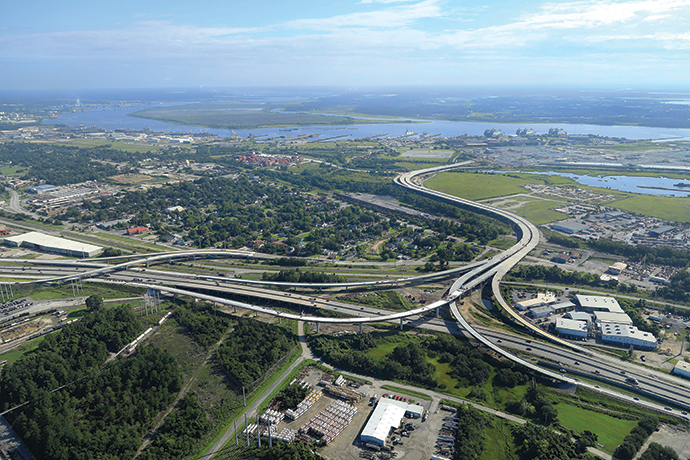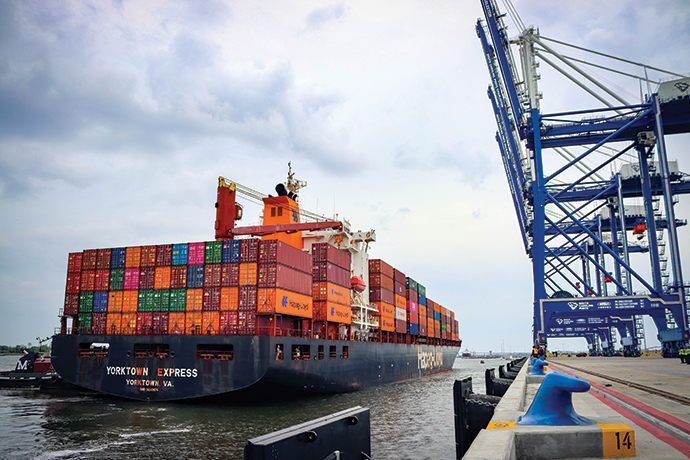These are heady times for the South Carolina Ports Authority. As congested ports at several locations in the country make ships wait for berths, vessels and commerce at the Port of Charleston remain as fluid as the water they float in on. No waiting. Plenty of opportunity.
The Port made history in March 2021 with record container volumes. Rail move volume was up strongly at Inland Port Greer and Inland Port Dillon too. So April was the perfect time for the Port to officially open the Hugh K. Leatherman Terminal on the Cooper River. It’s the first container terminal to open in the U.S. since 2009. Phase one will add 700,000 TEUs of throughput capacity to the Port of Charleston and an additional berth to the East Coast port market at a time of unprecedented, sustained demand.
“The Hugh K. Leatherman Terminal is an investment in the future of South Carolina that will spur economic development, create jobs and further our state’s position as an international business destination for years to come,” said South Carolina Governor Henry McMaster.
The Leatherman Terminal is part of SC Ports’ $2 billion infrastructure investment plan, which also involves enhancing Wando Welch Terminal. With these combined investments, SC Ports can handle four 14,000-TEU vessels simultaneously.
SC Ports’ Senior Vice President of Marketing and Sales Micah Mallace says it couldn’t come at a better time — literally. The world watched as a ship blocking the Suez Canal threw the world’s largest monkey wrench into global commerce. Even after the Ever After was freed, schedules for ports, shippers, truckers, railroads and customers were bunched. Six weekly ships at the Port of Charleston — 28% of its total volume — transit the Suez. But Mallace is sanguine.

“We are fortunate that our gateway has capacity when effectively no one else does.”
“We’re in the very fortunate position where we’ll be able to handle whatever comes,” he says. While a year of supply chain frustrations and challenges continues for many, “we have remained fluid,” he says. The bunched-up Suez vessels were expected to arrive on the East Coast in late April, concurrent with the Leatherman Terminal ramp-up. “It very well could be just in the nick of time,” Mallace says.
Just in time is an odd description for a project that took 20 years to come to fruition. “The thing that strikes me about the Leatherman Terminal is it’s such a bellwether of our business,” Mallace says. “The delivery timeline was slowed down in the Great Recession. Then in more recent years, it was, ‘Holy cow, we need to expedite this.’ And now we’re talking already about the second phase. Previous forecasts for that next tranche of capacity were much further out at 30 years, and now we’re talking a decade. It’s incredible, and indicative of the Southeast market we serve being such a boom area.”
Any Time, Any Tide
The addition of the Leatherman Terminal, as well as continuing improvements in the Port’s other services, means “we will be able to continue the normal cadence of throughput,” Mallace says.
Normal cadence? Customers crave soothing language like that, with its promise of dependable operations. In SC Ports’ case, it’s more than a promise.
“SC Ports has invested in port terminals, which is crucial as we continually expand in the Lowcountry,” says Tim Smith, executive vice president of business development for Lineage Logistics, the world’s largest industrial REIT for temperature-controlled real estate. The company in March expanded its site in North Charleston with a $34 million investment.
Since 2011, SC Ports’ refrigerated cargo business has more than doubled with 110% growth for loaded containers. SC Ports recently expanded the reefer container service area at Wando Welch Terminal and built a new reefer container service area at the Leatherman Terminal.
“We can confidently count on SC Ports to provide efficient operations and excellent cold-storage capabilities to support our growth, and we are excited about our future ahead in the region,” said Smith.
Giving shippers and customers further confidence, the Charleston Harbor deepening project will yield 52 feet of depth in 2021, making it the deepest harbor on the East Coast.
Green Lights All the Way
Costs seem to be flowing in Charleston’s favor too: Just as global retailers are getting faster approval from their boards to expand their supply chain infrastructure, new analysis reveals labor costs at the Port are the lowest among the top 10 U.S. container ports, with costs going down over the last three years while nearly every other port’s costs have risen. Similarly, says Mallace, “we’ve seen local trucking costs go up exponentially in a lot of the major port markets the last 12 months, and they really haven’t changed in Charleston.”
Ah, but the things that are changing are all for the better: A new access road to the Leatherman Terminal just opened up and is rapidly going from a proving ground for some people’s sports cars to being covered up with truck traffic.

As crane commissioning neared completion, “the heavy lift right now is on the computer screens at our office,” Mallace says. “After physical infrastructure, IT infrastructure is the most critical to a productive cadence at a terminal. We are in the process of delivering a new terminal operating system for all of our terminals and operations — tens of millions of dollars and years of work coming to a head over the course of this year.”
As global commerce reopens, it’s a unique moment in history. In South Carolina, as new projects and systems roll out like clockwork, it’s a unique moment in time, like hitting all green traffic lights as you skate across town on your favorite drive.
“We have invested in the right infrastructure at the right time to handle growing cargo volumes and bigger ships, ensuring SC Ports remains a top 10 U.S. container port,” said SC Ports CEO Jim Newsome at the Leatherman Terminal opening. “Tomorrow is here at SC Ports.”
This Investment Profile has been prepared under the auspices of South Carolina Ports Authority. For more information, visit www.scspa.com/toolkit.

